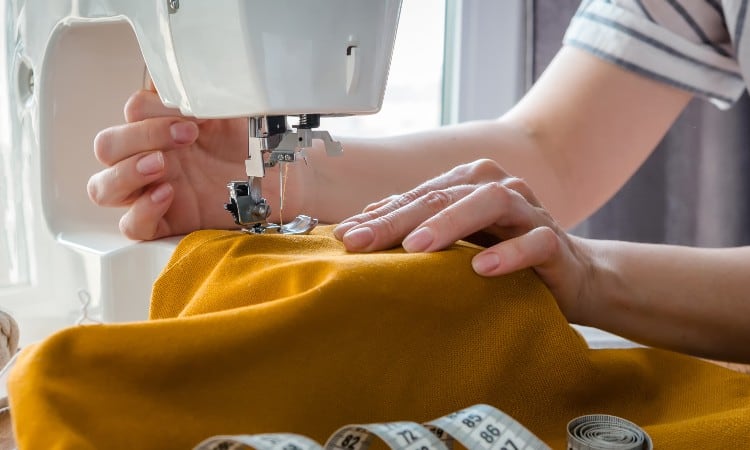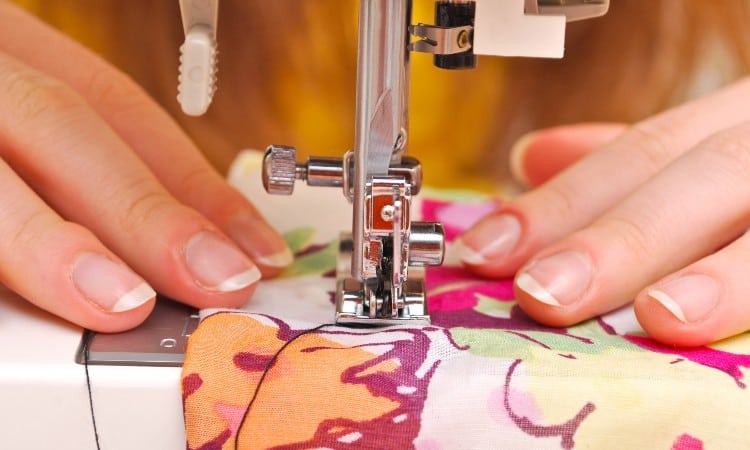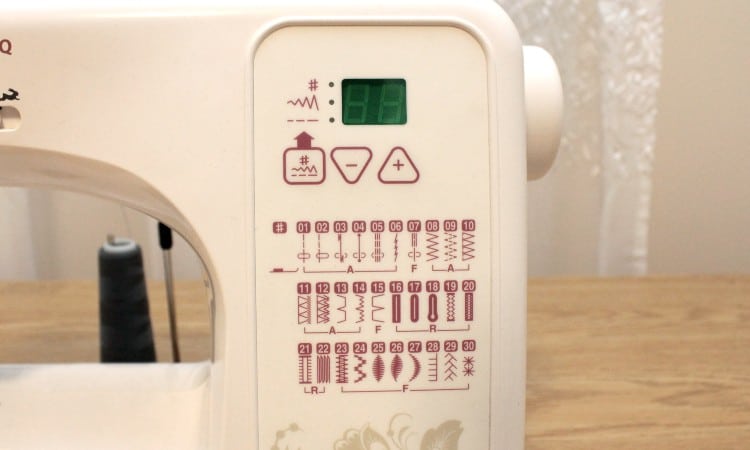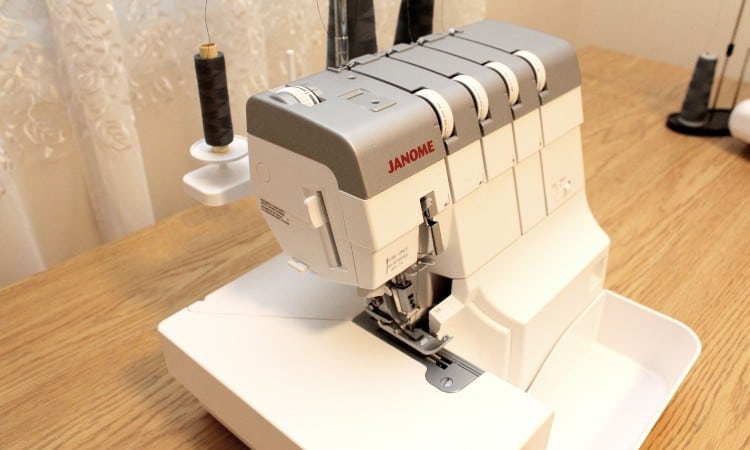Do you want to make your own maxi dress before you visit the beach this summer? Or perhaps you want to sew t-shirts that fit better than a store-bought style. Either way, you will need to master a few special techniques as you learn how to sew knit fabric.
The best way to sew knit fabric for clothes is to use a serger or overlocker that uses looped threads to create seams. Another popular method for sewing on knit fabrics is to use a regular sewing machine set to a zigzag stitch that can move with the flexible knit material. Using the correct needle and accessories like stabilizers also makes sewing on knits much easier.
In this article, you will learn why sewing on knits is so tricky. You will discover six popular ways to successfully sew knit fabric. Finally, you will find some fun hacks to make the process even easier!

Knit Fabric Sewing Supplies
Having the right sewing supplies makes sewing on knit fabrics much easier, whether you choose to sew by hand, on a regular sewing machine, or on a specialty machine like a serger. The biggest challenge of sewing knit materials is that this fabric can easily stretch out of shape as you try to stitch it. The right supplies can help prevent stretching.
Can you sew on knit fabric using the same sharp needle and straight stitch you use on your sewing machine for other types of cloth? Not really.
If you look closely at fabric types like satin or quilting cotton, you will notice tiny threads crisscrossing over and under each other at right angles. In some kinds of cloth like satin, more than one thread crosses at a time. A sharp or “normal” sewing needle can easily poke through the right-angle threads, and a straight stitch often makes the best seams on this kind of material because it aligns in a straight line with the woven pattern of the threads.
But if you look closely at knit fabric, you will not see this basket-like pattern of threads. Instead, you will see what looks like rows of braids made from many circles of thread. This is because most knit fabrics use just one super-long thread, forming a piece of cloth by knitting millions of tiny loops in that one thread.
 A sharp needle tends to catch on those tiny loops and snag them. You should always use a ballpoint needle when sewing knit fabric.
A sharp needle tends to catch on those tiny loops and snag them. You should always use a ballpoint needle when sewing knit fabric.
You may also notice that knit fabric is stretchy, unlike a stiffer material like quilting cotton. The looped structure of this type of material makes it much more stretchy, which is why you should not use a straight stitch to make a seam on knit fabric. Always try to use a stitch that can stretch with the expansion and contraction of the stretchy loops, such as a zigzag or stretch stitch.
The best supplies to use with knit fabric include:
- Ballpoint needles like these Singer ballpoint needles for most sewing machine models. This matters because the blunted, rounded needle point will slide through the threads instead of catching and snagging them. Sewing with a sharp needle on knit fabric often leads to skipped stitches or tangled seams.
- Likewise, use pattern weights or sewing clips instead of regular sewing pins. Sharp pinpoints can also damage knit fabric.
- A sewing machine that can use a walking foot instead of a regular presser foot if possible. A walking foot like this one moves knit fabric beneath the needle at an even, smooth pace to avoid stretching it out.
- A sewing machine that has a “stretch stitch” setting. You can learn more about what a stretch stitch does later in this article!
- Better yet, use a serger if you have one! Sergers/overlock machines use looped threads that can stretch and flex with the loops in the cloth, which makes sergers a great choice for seams on knit cloth.
- Polyester thread usually works better with knit fabric than cotton thread because the cotton thread does not stretch at all and can cause seams to pucker. Normally you should always match the fabric content of your thread to the fabric content of the material you want to sew, but in this case, polyester thread almost always works better.
- Finally, stabilizers like this knit stay tape can also help you sew perfect seams on knit fabric without stretching or puckering.
Using the right supplies will set you up for success as you sew with knit fabrics. But the right supplies will only take you so far. You also need to know how to use them!
How to Sew Knit Fabric: 6 Methods

The best way to sew on knit fabric for many projects is to use either a serger or a sewing machine with a stretch stitch setting. If you do not have those options, you can successfully sew on knits using a regular sewing machine with a zigzag stitch, too.
Knit Fabric Preparation
The first step in sewing knit fabric needs to happen before you sit down at the sewing machine as you prep and cut out the material. You should use these preparation steps for every project you plan to sew using knit fabric, no matter which method you use to stitch the material.
- First, pick a fabric that has good resiliency by stretching it up and down and then side-to-side, noting if the fabric rebounds into its original shape. All knit fabrics stretch easily, but good quality material can reclaim its shape instead of being stretched out.
- Second, always prewash your material in a gentle, cold-water cycle. If possible, hang the material to dry instead of putting it through the dryer. Knit fabric can shrink a lot in the wash, so you want to wash it before you cut out and sew it, or your garment will end up much too small the first time you wash it!
- Make sure you either hang the fabric on a shower curtain and steam out the wrinkles or gently iron out any wrinkles before cutting.
- To cut out pattern pieces from knit fabric, make sure you find the grainline by looking for the direction of the tiny “braids” of thread in the cloth. You cannot align the selvage as you would with a plain-weave fabric to do this.
- Also, stretch the fabric crosswise–the opposite direction of the looped braids–and check to see which way the edge of the fabric curls. It will curl toward the right side of the cloth, and you want to make sure you cut pattern pieces so that the right side will face outwards on the finished garment.
- When you place pattern pieces on the cloth, use weights to hold the pieces instead of pins.
- For knits with wales or raised ridges across the surface, cut out all the pattern pieces using the wales like a grainline to make sure the rows will line up with each other when you sew the garment.
- For knit fabric with spandex or Lycra in it, like the material you use to make leggings, cut the pattern pieces out so that the fabric will stretch horizontally across your body.
Sewing Machine

You can use a zigzag stitch if you need to sew something out of knit fabric on a regular sewing machine without many special accessories.
- First, you need to use a ballpoint needle in your sewing machine. You can get away without using any other accessories, but you have to use a blunt needle with knits.
- Next, test your zigzag stitch on a scrap of the material before you start sewing for real. For most fine-knit fabric, set your machine to a zigzag stitch with a 2.5 mm length and a .7 to 1.5 width. This creates an almost-flat zigzag, but the seam can still flex with the fabric, unlike a straight stitch. For a loosely knit fabric, you may want to try a bigger zigzag stitch with a setting of a 3 or even 3.5 height.
- If the test scrap puckers shows skipped stitches or looks stretched out around the stitching, you need to adjust the length or width of the zigzag.
- Try not to push or pull on the fabric as you stitch a seam. A regular presser foot can sometimes cause knit fabric to stretch out, and if you pull on it, it will certainly stretch!
- As a pro tip, you may also find that it helps to adjust the presser foot height if your machine allows this. If it does not, try pausing and raising the presser foot periodically to lessen the strain on the cloth.
- For curved seams on a garment, like armholes, you will need to use a stabilizer to avoid stretching out the material as you sew.
- For necklines, you will often want to use a binding rather than a facing because the curved neck hole will almost always stretch out if you try to sew it with a zigzag stitch.
- You do not need to finish the edges of your seams after you sew them. Knit material does not fray, so you can leave raw edges on most seams!
Sewing Machine with Stabilizer
 Another way to sew knit fabric with a regular sewing machine is to use stabilizers to help prevent stretching. This can help prevent the waves that form when the edge of a knit fabric gets stretched out.
Another way to sew knit fabric with a regular sewing machine is to use stabilizers to help prevent stretching. This can help prevent the waves that form when the edge of a knit fabric gets stretched out.
You can use several different types of stabilizers. Nylon mesh cutaway stabilizers like this one can iron onto the fabric in key areas to prevent it from stretching. For fine or see-through types of knits, like some stretchy, lacey materials, you may want to use water-soluble stabilizers like this one that will come off in the wash so they do not show.
Another common practice for hemming is to use thin strips of stabilizer like this knit stay tape to keep the hemline from stretching.
Using a stabilizer is especially important for curved seams, like armholes or curved hems. While a stabilizer does especially help when you need to use a regular sewing machine to sew knits, you will also find it a useful tool when you use a serger.
- Apply iron-on stabilizers to the fabric using a heated iron, which melts the shiny side of the stabilizer into the fabric.
- Make sure you apply the stabilizer to the wrong side of the fabric because you want it to disappear inside the garment once you finish!
- Set your machine to a zigzag stitch as you did in the previous section.
- Gently feed the material through the machine. The stabilizer will keep the loops in the knitted material from stretching out.
Sewing Machine with Stretch Stitch

The best way to sew knit fabric using a regular sewing machine is to use a stretch or elastic stitch setting and a walking foot. These special features allow the machine to accommodate the stretch and give of knit cloth.
How do you know if your sewing machine can do a stretch stitch? Check your owner’s manual and read through the stitch settings section. Or look at the stitch-selection menu on the machine itself and see if you can find a symbol that looks like a lightning bolt with a zigzag with a longer stitch and a shorter stitch.
Another type of stretch stitch you can use to sew on knits is the triple stitch. This stitch often has a confusing symbol on a sewing machine menu of three vertical lines next to each other. But the triple stitch uses a forward-and-back motion to stitch on top of the same spot three times, creating a strong, stretchy stitch great for many types of knit material.
If you use the triple stretch stitch, you may need to adjust the length of the stitch to accommodate your fabric. To do this, run a test by sewing six inches down a scrap of fabric. If the stitches lie smooth and flat, the stitch length works. If the stitches pucker or pull, try adjusting the length until they lie flat.
A walking foot replaces the regular presser foot on a sewing machine, snapping in just as you would swap out a zipper foot for a presser foot when you need to sew a zipper. The walking foot can move difficult fabric beneath the needle in a smooth, even progression. It works well for many challenging types of materials like knits, vinyl, and the thick layers of a quilt.
Serger

At least 90% of the time, the best way to sew seams on knit fabric is to use a serger, also known as an overlock machine. Sergers work better than most sewing machines to sew knits for several reasons.
First, sergers use differentiated feed, which means they have two sets of feed dogs to feed fabric beneath the needle. This helps prevent any stretching. Second, serges also have better support for the fabric as it slides through.
But perhaps the main reason sergers work better is that they use multiple threads, often three, four, or five, to create looped cases around seams that can stretch and flex with the loops in the knit fabric.
A serger forms a seam, cuts off the seam allowance, and finishes the raw edge of the fabric all at the same time. Sergers can often form several types of stitches, including a rolled hem perfect for knits. The basic overlock stitch for seams uses three or four threads and multiple loopers beneath the needle to form a casing around the edge of the stitch.
You can buy an affordable, beginner-level serger like this No products found. for around $300. If you plan to sew a lot of t-shirts, leggings, swimsuits, or undergarments, you may want to make that investment.
If you have not used a serger before, you will find threading the machine quite challenging. It is a good idea to buy a beginner model with color-coded guides for the multiple thread paths.
By Hand

The best way to hand-sew knit fabric is to use a hand-made stretch stitch, sometimes called a herringbone stitch. This works well if you need to hand-sew a seam in stretchy fabric.
- Start by using a washable fabric pen to draw two parallel lines about ¼” apart down the length you want to sew.
- Knot the tail of the thread and form your first herringbone stitch by making a diagonal stitch left to right from the bottom line to the top line. Then bring the needle back up on the top line and backstitch in a diagonal back to the bottom line, forming a slanted “X” shape with the two stitches.
- Continue the slanted X stitches until you fill in the whole space and finish your seam.
- Knot the thread again to end the seam.
If you want to hand-sew embroidery onto knit fabric, you will need to use a stabilizer on the back side of the material. Generally speaking, a knit fabric is not the best medium for embroidery because it is too soft and stretchy. But if you want to add logos to a t-shirt, for example, you can accomplish that by adding a stabilizer.
What Needle Should You Use for Knit Fabric?
 You should always use a ballpoint needle to sew knit fabric. This holds true whether you use a sewing machine, a serger, or a hand-sewing needle.
You should always use a ballpoint needle to sew knit fabric. This holds true whether you use a sewing machine, a serger, or a hand-sewing needle.
- A size 60/80 ballpoint works well for very light, fine knits.
- A size 70/10 ballpoint can also work well on lightweight or jersey knits like t-shirt fabric.
- A size 80/12 is probably the most common ballpoint needle to use with knits. It works well on midweight knits.
- A size 90/14 can work on thicker knits like the terry fleece you use in bathrobes.
Best Thread for Knit Fabric

Most of the time, polyester thread works best with knit fabrics. However, you can also use a variety of other threads depending on the type of fabric you plan to sew.
- Polyester thread or bonded polyester thread works well for most sewing projects using knits. Polyester thread has a little more stretch than cotton thread. As an added benefit, it may cost less, too!
- Stretch thread works well with extra-stretchy types of cloth that contain elastane, Lycra, or Spandex. This type of thread does not contain elastic fibers, but it uses a special type of nylon to create soft and stretchy seams.
- In some cases, you can also sew with straight-up elastic thread, especially if you need to gather knits.
- Woolly nylon thread works well on sergers, though not on regular sewing machines. This type of thread has a texture and a good stretch, which makes it a popular, though pricey, choice for sewing on knits with a serger.
- For a serger, you can use polyester thread for knits, but you will want to buy the thread in large cones rather than small spools.
What is the Best Stitch for Knit Fabric?
The best stitch for knit fabric is a zigzag, a stretch stitch, a triple stretch stitch, an overlocked stitch, or a herringbone stitch. Usually, the best stitch to choose depends on what type of sewing you plan to use.
- For a sewing machine, the best stitch is a “lightning bolt” stretch stitch or a triple stretch stitch if your machine has that feature. If it does not, use a zigzag stitch.
- A flatlock three or four-thread stitch works best on an overlocker/serger.
- A herringbone stitch works best when sewing on knits by hand.
How To Sew Knit Fabric Without Stretching It?
You can use several techniques to sew knit fabric without stretching it, including using a serger, adjusting the presser foot, using a walking foot, using the differentiated feed setting, and using fabric stabilizers.
The best way to sew knit fabric without stretching it is to use a serger. The whole design of a serger works better with knits as it does not pull on them and creates a looped seam that flexes with the fabric.
On a regular sewing machine, you may notice that your material stretches out as it passes beneath the needle and then forms stretched-out wavey shapes that won’t go away. This happens because the pressure between the presser foot and the feed dogs pulls too hard on the cloth and stretches it out permanently.
To adjust this, your machine may allow you to raise the presser foot slightly so it does not press down so firmly.
Another option on some sewing machines is to use differentiated feed. High-end sewing machines often have two sets of feed dogs that can adjust how quickly fabric moves over the needle plate.
Using a walking foot instead of a regular presser foot can also help the knit fabric move easily beneath the needle without stretching out.
If you need to sew on knits by hand, use a herringbone stitch incorporating an X shape for flexibility and a backstitch for security.
Finally, adding a fusible, cut-away, or water-soluble stabilizer helps prevent stretching in tricky areas like rounded necklines, armholes, or hems. It is a good idea to use a stabilizer for any curves you plan to sew on knit material, whether you use a sewing machine or a serger.
Hacks and Tips for Sewing With Knit Fabric
As you begin sewing with knits, you may find it helpful to try out a few hacks and tips, like using an iron when necessary or adding tissue paper to a seam for stability.
- If you sew a seam on knit fabric and notice the dreaded stretch waves when you finish, try gently pressing with an iron and then allowing the fabric to cool entirely without moving it. In some cases, this can “unstretch” the loops in the material, returning it to its original shape.
- If you do not have a real fabric stabilizer, try cutting out a strip of regular white tissue paper and placing it on top of the cloth before you sew or serge the fabric. This can help prevent uneven or loose stitching on knits. Once you finish, simply tear away the paper–it will come out easily!
- If you see puckered or wonky stitches as you sew, make sure to check the presser foot pressure. But also, make sure you let the machine pull the fabric through in a flat line rather than pushing it through yourself.
Conclusion
Sewing on knit fabric takes special tactics you can easily master, such as using a zigzag or stretch stitch instead of a regular straight stitch. The easiest way to sew on knit fabric is to use a serger, which forms a seam and looped casing around the raw edge all at once. A regular sewing machine can sew on knits, especially if it features a stretch stitch, differentiated feed, and/or a walking foot.
Remember to use polyester or stretch thread when sewing on knits. Using stabilizers such as fusible fabric stabilizers can help prevent the cloth from stretching out around curved edges or hems.
Have you ever tried to sew with knit fabric? What did you find most difficult? Leave a comment below to let us know!